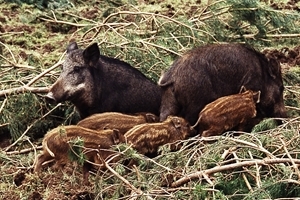Wild boar
 After an absence of approximately 700 years, wild boar are roaming and breeding in the British countryside once again! It is thought that the original British wild boar probably became extinct by the 13th century. Following on from then, a number of re-introduced animals had also become extinct by the 17th century so that, until fairly recently, no free-living wild boar have been present in Britain.
After an absence of approximately 700 years, wild boar are roaming and breeding in the British countryside once again! It is thought that the original British wild boar probably became extinct by the 13th century. Following on from then, a number of re-introduced animals had also become extinct by the 17th century so that, until fairly recently, no free-living wild boar have been present in Britain.
However, nowadays wild boar sightings are reported from right across much of England and Wales, however most of these are possibly people spotting wandering individuals. This is because there are probably at present, only four sustainable populations. The two best known are those in the Weald in Kent/Sussex and those in the Forest of Dean, Gloucestershire. The Kent/Sussex population is the oldest, but that in the Forest of Dean is the largest and most widespread. There are two other small established populations reported in South Devon and the Brecon Beacons, but the actual numbers involved is unknown.
Adult boar have thick bristly coats ranging in colour from brown, red-brown, dark grey or even black and the bristles are brindled with white or tan tips. Piglets have characteristic brown and cream longitudinal stripes making them look like little humbugs! These stripes are lost when the piglet is 3 to 4 months old, when the piglet then takes on a red colouration (reminiscent of a red squirrel's colouration) until it becomes an adult at approximately one year of age.
An adult boar’s body shape is “front-loaded” with a large head and shoulders tapering to smaller hind quarters. The body weight is also concentrated in the front half of the animal with a mature male being an impressive beast, potentially weighing up to 200kg (31 stone), while females are generally smaller, weighing up to 130kg (20 stone). The maximum height reached for both sexes is about 1 metre. It goes without saying that you do not want to prang into one on a dark night, as your car might not look great afterwards!
Wild boar have exceptional hearing and sense of smell, but poor eyesight. They are very vocal and constantly communicate with other group members through a series of grunts and squeals. They are mainly nocturnal and prefer to live in small social groups referred to as sounders. Sounders are matriarchal and organised around a core of two or three mature reproductive females with their most recent litters, plus the surviving young and sub-adults from previous litters. Group size varies between six and 30 animals. Mature males tend to be found in the vicinity of the group only during the breeding season.
Farrowing (giving birth) can occur at just about any time but peaks in April, with a typical litter size usually being between 4-6 piglets. I have seen newly born piglets in December, scampering around in the snow in Italy. Wild boar are omnivorous and will consume a large variety of food items, but plant material usually accounts for 90% of their diet and animal matter the remaining 10%. Plant matter consists of roots, bulbs and tubers, unearthed by rooting with their long snouts, which can leave pastures literally looking as though they have been ploughed!
Animal matter can consist of mice, bird’s eggs, snakes, lizards, worms, beetles and carrion. The diet changes to accommodate seasonally available items and forest fruits (for example, acorns, beech mast, chestnuts) are particularly sought after. In times of shortage, agricultural crops are sometimes raided, particularly fields of maize, turnips and potatoes.
In some countries this habit has turned wild boar into an agricultural pest, whilst in a number of urban areas they have also become a public menace, raiding gardens and turning over rubbish bins. For instance in Berlin they cull around 2,000 “feral” boar annually, to keep them in check.
However, elsewhere in Europe the hunting of wild boar is economically and culturally important, to the extent that supplementary feeding sometimes is used to ensure populations are maintained. In some regions hunters are responsible for compensating for the damage boar create outside the hunting areas.
Generally wild boar keep themselves to themselves, with only the occasional incident involving a pet dog being injured. Sows with young piglets are potentially more dangerous than other boar because they may attempt to defend their young.
Time will tell if they are to become a common sight in your neck of the woods!
Peter Thompson
Advisory
Read more from Peter Thompson at the Fresh from the Field blog.

Download Peter Thompson's essential 26-page book, featuring beautiful photography and detailed profiles of Britain's wildlife
Download FREE >